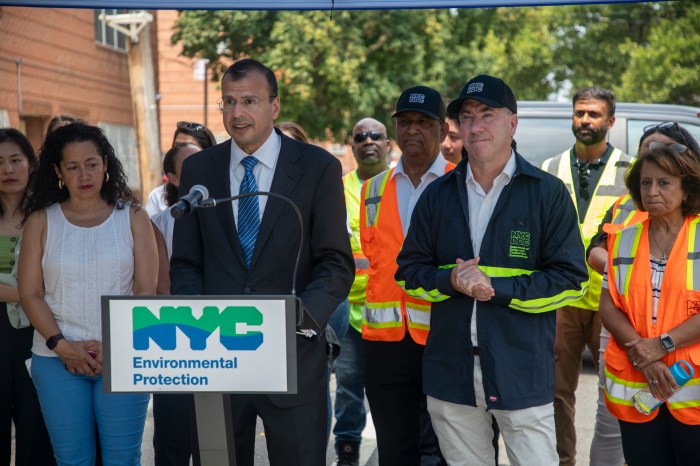Mayor Eric Adams on Wednesday unveiled a new plan aimed at ensuring New York City’s position as a leader in the newly-emerging environmentally-conscious economy.
In partnership with New York City Economic Development Corporation (NYCEDC) and the mayor’s Office of Talent and Workforce Development (NYCTalent), Adams on Feb. 28 announced a new Green Economy Action Plan which seeks to expand on the city’s existing environmental sector by investing in new jobs and initiatives which combat climate change.
The first-of-its-kind plan will help train New Yorkers — particularly those from environmentally disenfranchised communities — to help fill the 400,000 “green-collar” jobs projected to be available in the Big Apple by 2040, dramatically more than the estimated 133,000 available today.
This plan is different from the mayor’s “PlaNYC: Getting Sustainability Done” which was released last year and highlights the longterm steps the city is taking to protect New Yorkers from the dangers caused by climate change.

“Our city didn’t recover the nearly 1 million jobs we lost during the pandemic and reach a new private-sector job high by looking backward — we did it by building an economy of the future,” said Adams. “And we must draw on all our resources to protect our city from the effects of climate change.”
According to the mayor’s office, the new Action Plan will work to simultaneously address and resolve issues caused by climate change, while providing a stable and prosperous economy while providing some economic advancement to individuals who may not have otherwise had the opportunity.
The plan highlights new approaches and opportunities embedded in various communities to help New Yorkers get a jumpstart on their environmentally-conscious futures.
Some of these new approaches include the establishment of a Climate Innovation Hub at the Brooklyn Army Terminal, made possible through a $100 million donation from NYCEDC. The new space is designed to serve as a means to accelerate commercial pathways for climate tech startup companies. An estimated 150 startups will be served over the course of ten years, generating a projected $2.6 billion in local economic growth as well as the creation of 600 local and ‘green-collar’ jobs.
Another impactful part of the plan includes the creation of green training facilities available in every borough of the city. NYCTalent, in collaboration with other partners, will establish environmentally-geared workforce training programs, generating over 12,000 green apprenticeships by 2040.
Adams was quick to highlight the other previous contributions his office has made in efforts to make NYC a more environmentally conscious city and how expanding on these existing practices will fuel a more green future.
“From building resiliency projects and retrofitting apartment buildings, to installing solar panels, EV charging stations, and wind turbines, ‘green-collar’ jobs are already in demand and leading the way,” he said. “Our Green Economy Action Plan will harness the growth of a new kind of industrial revolution and give New Yorkers the tools they need to build a resilient and prosperous city and thrive in our future-focused economy.”

NYCEDC President and CEO Andrew Kimball highlighted some of the initiatives made possible by the new Green Economy Action Plan.
“There is no better location for innovation than at the historic Brooklyn Army Terminal, located on the waterfront in the heart of Sunset Park, which is turning into a center for clean tech innovation and manufacturing,” Kimball said. “Climate tech growth at the Brooklyn Army Terminal will be further catalyzed by the establishment of the Climate Innovation Hub and through a unique partnership with the Brooklyn Navy Yard and the Trust for Governors Island, known as the Harbor Climate Collaborative. Collectively, these three remarkable city assets, all connected by a short NYC Ferry ride, will be at the forefront of climate innovation, commercialization, and workforce development for decades to come.”
Other elected officials echoed the importance of transitioning to more environmentally-conscious economic practices within the city, citing the growing dangers of climate change.
“Treating the climate change crisis with the urgency it requires doesn’t just support our infrastructure but our economy too, with good, ‘green-collar’ jobs for New Yorkers with diverse educations and histories,” said Deputy Mayor for Operations Meera Joshi. “As unusual weather events become all too usual, we all have a role to play in protecting our city. Our city is creating the framework so that everyone can get involved.”
























